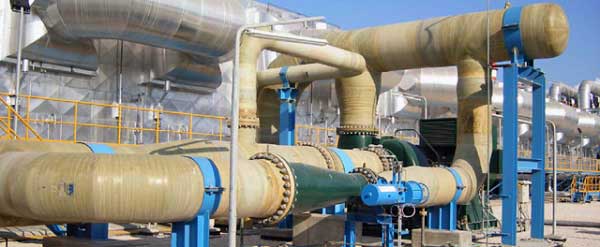 |
Differences - GRE pipe & GRP pipe |
The main difference between the two is in the resin used to bond the fiberglass. GRE uses epoxy resin, while GRP pipes use isophthalic resin. Various raw materials can be added during fabrication to improve performance.
Historically, the petrochemical piping industry and the oil and gas sector have experienced the constant replacement of piping systems due to corrosion. As a result, pipes cost three to four times more than the original investment and metal and steel pipe maintenance is a costly affair.
Fiberglass strengthened pipes have gained tremendous popularity in recent years as an excellent alternative to expensive steel, especially because of their corrosion-free life. These pipes have received special attention in industries other than the O&G industry, such as chemical, offshore and marine.
Besides being low-maintenance and cost-effective, these pipes are also lightweight, electrostatically conductive, non-corrosive and non-erosive. Fiber Reinforced Pipes are popularly known as Fiber Reinforced Pipes or FRP. They include Glass Reinforced Plastic (GRP) and Glass Reinforced Epoxy (GRE), which makes the pipe strong enough to withstand higher temperatures.
Higher temperature resistance can be obtained with phenolic resin to make the tubes resistant to temperatures up to 3,000 degrees Celsius. Similarly, static conductivity can be achieved by adding carbon or graphite fibers.

Features of GRP pipes
GRP pipes are resistant to corrosion
These pipes are comparatively more corrosion resistant due to the nature of the materials used to manufacture them. Most piping systems last for decades, especially if the right barriers protect them from different environments.
GRP pipes are lightweight
The weight of a typical pipe is nearly 30% less than the weight of steel counterparts and 12% less than concrete pipes. This means significantly lower shipping, handling, transportation and installation costs.
GRP pipes conduct electricity
High-performance pipes do not conduct electricity and therefore have better electrical properties than steel or metal pipes. In situations where electrical conduction is required but cost savings are also essential, it is possible to add conductive reinforced fillers or fibers during pipe fabrication. The composite structure of pipes allows them to be cost-effectively adapted to different project requirements.
GRP pipes are excellent pressure absorbers
These pipes are designed to absorb up to 37% of peak pressure, making them excellent for high-pressure applications. There is also no need to increase the pressure rating to take advantage of this property.
The strength-to-weight ratio and fatigue endurance provides additional benefits associated with designing lightweight piping and reducing replacement costs or downtime. The smooth inner surface leads to minimal friction loss over the life of these pipes.
Features of GRE pipes
The smooth inner surface and easy handling of lightweight GRE pipes provide high flow capacity and less friction. These pipes have relatively low thermal conductivity, minimizing heat loss and the additional cost of insulation.
In addition, they are well suited for environments where resistance to corrosion and chemicals is important. They also offer a unique combination of thermal and mechanical resistance because they are made from a selection of high-quality elements. If weathering is an issue, UV inhibitors can be added to cost-effectively improve efficiency. Once properly installed, GRE pipes are virtually maintenance-free.
GRE pipes also offer exceptional hydraulic properties to increase flow volume. Less friction means less energy is used for pumping, resulting in lower operating costs. The pipes also have a long service life and can withstand overpressure. Because they can withstand harsh conditions, they are perfect for use in chemical plants, oil and gas exploration, desalination plants and many other applications.
Which type of pipeline you should invest in depends on many factors that make your project unique. Industrial, offshore, marine and oil and gas applications require pipes that are resistant to corrosion and medium to high pressure, but they also require certain technical characteristics for improved efficiency.
Related Post(s)

FRP stands for Fiber Reinforced Plastic and has been widely used in process, water and chemical industries due to their high resistance to corrosion...